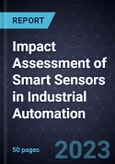Connected Intelligent Sensors Increase Efficiency, ROI, & Margin
Smart sensors employ microelectromechanical systems (MEMS) and very-large-scale integration (VLSI) technology to function effectively. A smart sensor is a device that receives input from the physical world, and upon detection, leverages internal computing power to carry out predefined actions to provide optimized output. Key operations of smart sensors include measurement, configuration, verification, and communication. Performance capabilities, such as data processing, communication, multi-sensing, decision-making, and self-calibration/correction enable smart sensors to be employed in industrial applications. Optical sensing, UV and infrared detection, biological hazard identification, structural monitoring, and floor mapping are some of the current opportunities provided by smart sensors in an industrial setting.
Research efforts are driving technological developments in quantum sensing and neuromorphic chip-based sensors and leading to new application areas for smart sensors, such as continuous remote sensing in structural monitoring and sustainable IIoT infrastructure in remote locations and self-aware industrial equipment. The growing demand for decentralized and localized sensing electronic devices because of rapid digitization and the ability to carry out continuous remote monitoring across different industries (e.g., healthcare, industrial) are key market drivers. The reduced burden on centralized computing systems and better reliability due to the lack of dependence on a single system will drive adoption in the future.
The report covers the current state and impact of smart sensor technologies on industrial automation processes and provides an outlook on future developments.
The research report covers the following topics:
- Significance of the smart sensor and different configurations
- Recent trends and developments driving market opportunities
- Factors influencing technology development and Adoption
- Key innovators and key technologies driving smart sensor advancements
- Key growth opportunities in the industrial automation sector








